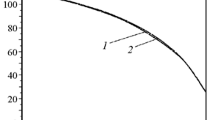Causes of reversible changes in the coercivity of alloys for permanent magnets as a result of cyclic heat treatment are analyzed. The magnetic properties and the metallographic and magnetic domain structures of alloy Sm(Co0.65Fe0.26Cu0.07Zr0.02)7 are studied as a function of the temperature of interruption of the process cooling. The own results and data of foreign authors are used for developing a scheme of the processes occurring in the alloy in order to explain the mechanism of the “damage – restoration” phenomenon in alloys of the Sm – Co – Cu – Fe – Zr system of type Sm(Co0.65Fe0.26Cu0.07Zr0.02)7.





Similar content being viewed by others
References
A. S. Lileev, V. V. Pinkas, K. V. Voronchihina, and A. V. Gunbin, “Research of reversibility of coercivity under heat treatment in permanent magnets,” in: Moscow International Symposium on Magnetism (MISM), 1 – 5 July, 2017, Moscow, Book of Abstracts, p. 826.
A. S. Lileev, V. P. Menushenkov, and V. I. Sumin, “Investigation of reversible changes of magnetic properties in alloy YuNDK35T5 after a “damage – restoration” heat treatment,” Fiz. Met. Metalloved., 36(1), 183 – 186 (1973).
B. G. Livshits, A. S. Lileev, and V. P. Menushenkov, “Reversibility of magnetic properties of sintered permanent magnets from SmCo5 compound,” Metally, No. 4, 161 – 164 (1976).
T. G.Woodcock, F. Bittner, T. Mix, et al., “On the reversible and fully repeatable increase in coercive field of sintered Nd – Fe – B magnets following post sinter annealing,” J. Magn. Magn. Mater., 360, 154 – 157 (2014).
X. Y. Xiong, T. Ohkubo, T. Koyama, et al., “The microstructure of sintered Sm(Co0.72Fe0.20Cu0.055Zr0.025)7.5 permanent magnet studied by atom probe,” Acta Mater., 52, 737 – 748 (2004).
O. A. Arinicheva, A. S. Lileev, M. Raizner, et al., “Effect of cyclic heat treatment in the range of 800 – 400°C on the properties of sintered magnets based on alloy Sm(Co, Fe, Cu, Zr)z,” Metalloved. Term. Obrab. Met., No. 11, 16 – 20 (2014).
O. Gutfleisch, K.-H Muller, K. Khlopkov, et al., “Evolution of magnetic domain structures and coercivity in high-performance SmCo 2:17-type permanent magnets,” Acta Mater., 54, 997 – 1008 (2006).
R. Gopalan, K. Hono, A. Yan, and O. Gutfleisch, “Direct evidence for Cu concentration and its correlation to coercivity in Sm(Co0.74Fe0.1Cu0.12Zr0.4)7.4 ribbons,” Scr. Mater., 60, 764 – 767 (2009).
H. Sepehri-Amin, J. Thielsch, J. Fischbacher et at., “Correlation of microchemistry of cell boundary phase and interface structure to the coercivity of Sm(Co0.784Fe0.100Cu0.088Zr0.028)7.19 sintered magnets,” Acta Mater., 126, 1 – 10 (2017).
C. Tikadzumi, The Physics of Ferromagnetism. Magnetic Characteristics and Applications [Russian translation], Mir, Moscow (1987), 420 p.
Author information
Authors and Affiliations
Corresponding author
Additional information
Translated from Metallovedenie i Termicheskaya Obrabotka Metallov, No. 8, pp. 4 – 8, August, 2018.
Rights and permissions
About this article
Cite this article
Lileev, A.S., Pinkas, V.V., Voronchikhina, K.V. et al. Reversible Changes of Coercive Force in Sm – Co – Cu – Fe – Zr Alloy for Permanent Magnets Under Cyclic Heat Treatment. Met Sci Heat Treat 60, 489–493 (2018). https://doi.org/10.1007/s11041-018-0306-2
Published:
Issue Date:
DOI: https://doi.org/10.1007/s11041-018-0306-2




